VISITING THE MAROOCHYDORE REGIONAL BUSHLAND BOTANIC GARDENS - SCULPTURE GARDEN...
We've been planning activities most days to get the children outdoors for at least a part of the day and we've been looking for activities away from the crowds... I have read on several occasions now about the sculpture gardens at the Maroochydore Botanical Gardens and it has been on my list of places to check out so we thought that it would make a good afternoon outing for the children...
At first they weren't too keen. Max thought it would be boring but once we got there, the kids loved it. One of the best things about the Sculpture Garden is that your children are free to wander and freely explore, touch, gaze, wonder, interpret and contemplate. Each of the sculptures are at ground level so it makes for a great tactile experience and each piece is unique with varying compositions. There are different materials from timber and metal, rough sandstone and smooth marble and their exploration allows for lots of questions about the materials, to whether they like the pieces or not. They are free to run but at the same time, the garden gives a sense of peace and it's a great place to unwind...
The gardens came aboout in 1997 when the Sunshine Coast Council had some great forethought, and they purchased 112 hectares of rainforest in the Sunshine Coast hinterland to become an oasis and an escape in the form of a botanic garden for the public. After a masterplan was drawn up, several years of construction and careful planning; the Maroochy Bushland Botanic Gardens are now a haven for native flora, fauna, kids and adults. Set on the side of a hill, the gardens comprise of a few separate gardens, connected by paths and separated by thick, lush rainforest.
There are a few other walks that we are keen to do also, including the Whipbird Walk, Mossy Log Walk, Ephemeral Wetlands Walk, Fern Glad Walk, Creek Walk and the Lagoon Walk but they will have to wait for another day. At this rate, we will be able to plan several more visits here with the kids to keep them entertained in the future...
The thing about the Sculpture Gardens walk, is that the Council has an app that allows you to learn more about each piece as you walk around the garden. The children were keen to listen to the dialogue on each piece and they were also keen to look for the frogs that were associated with some of the pieces we saw...
The first Sculpture that we came across was titled "Spirit House"and was created by Craig Medson from Maleny, QLD and was made from Helidon Sandstone. The children were hugely impressed by the fact that they could push the top of the sculpture and it rotate around...
This is not the original sculpture created by Craig. The first Spirit House developed a crack from within its heart, and was replaced by this new work. The original work was removed due to safety concerns but can still be viewed, in the horizontal, near the picnic shelter in the Sculpture Garden near the end of the trail. The three white marble cylinders within the fold of the sculpture represent 'family'. Lean against the sculpture and the sculpture rotates on a stainless steel shaft and bearing. Craig Medson and his wife Fiona, who is also a sculptor, project-managed the Sculpture Symposium in 2005, inviting artists they had worked with in other symposia overseas.
In the early days, when volunteers were working at clearing the bush of weeds and exotic trees, a carpet snake, which they called Axminster, resided here. This sculpture by Silvio is fondly called Axminster by the Friends of the Gardens. Silvio finished the sculpting, but after the initial work was finished, the sculpture needed to be polished. Volunteers wore out many fingertip rubber gloves doing this polishing, starting with rough sandpaper and ending the process with the finest of sandpaper. Because volunteers did the polishing, Silvio could move on to a new sculpture, instead of spending his limited time polishing. The Python regularly gets a treatment of sanding and oiling to keep it shiny and you can feel the smoothness of the beautiful snake. Silvio sometimes, but not always, adds to his works a small frog which is not always easy to find. The kids were really keen to find this little frog and it didn't take them too long to find it. It then set the bar for finding the frogs with the rest of his works within the gardens as well.
 |
| They found the frog... |
As we continued along the path the next sculpture was the White Marble Torso created by an American artist, M.J. Anderson from Oregon in the USA. For this piece he used some White Chillagoe Marble.
He has several torsos in the Sculpture Garden which are distinctive and easily identified. The torsos are imperfect, as, in the artist's words - 'no woman's body i perfect'. This artist was able to do so much work in such a short time as only minimal stone had to removed to allow the natural shape of the rock to reveal the essence of a torso. This piece was created as a response to the natural shape of the stone, when the artist saw a figure in the stone to be 'released'. As a result of the popularity of her sculptures displayed in this Garden, M.J. was commissioned to do a marble sculpture in the Noosa Botanic Garden also.
"Goanna", the next sculpture we came across was also created by Silvio Appoyi and again he used the beautiful black Chillagoe Marble for this piece. Before even checking out the Goanna, the kids were keen to find the frog...
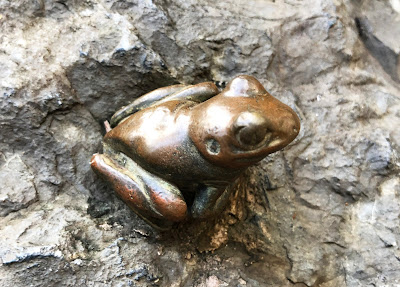 |
| And once again they found the little frog.. |
We came across another of M.J. Anderson's pieces titled "Casuarina Torso". This piece was created from Helidon Sandstone and it sits near a Casuarina tree, the position having been specifically requested by M.J. herself. She has never worked in sandstone before and found it very soft compared to marble. She therefore had to experiment with different tools and textures in the creation of this piece.
The gardens are beautiful kept and this beautiful grassed area is surrounded by some beautiful pieces. This grassed areas is right in the very centre of the Sculptured Gardens and is very quiet and peaceful.The first sculpture we came across in this areas was titled "The Gift" and was created by Dr Rhyll Hinwood who comes from Brisbane, in Queensland and was also created out of the beautiful Helidon Sandstone. The leaves around the sides of the sculpture are those of the Cabbage Tree Palm (Livistona Australis). A large living example of this palm can be seen near the pathway by the sandstone sculpture, The Cycle, to be found further along the trail.
The next piece titled "Chronicle" was really quite different to the other pieces we have seen and was created by Seung-Woo Hwang from South Korea. He used both the White and Black Chillagoe Marble to create this artwork. Hwang is interested in portraying history in his works. In this work he does this in two ways - the marble is carved to resemble a scroll of rolled paper with pages and letters on the vertical section, and on the bottom section on the right there is a black marble form (like a wooden roller from a historical scroll). If you put your ear to it, you can hear the wind of history passing through the scroll. This sculptor has cleverly hollowed out the bottom of this sculpture allowing air to pass through it, so the holes on the front can be played with your hands like a percussive instrument. Very interesting indeed...
The next piece titled "Pelican" was another of Silvio Appoyi's sculptures and was created using the White Chillagoe Marble this time. He was invited back to the Gardens again in 2006 and 2007 to create some more animal sculptures in marble. Silvio could 'see'a reclining Pelican in the natural shape of this marble block and felt they he just had to 'release' it from the stone.
The sculpture "The Embrace" was created by a Slovakian sculptor Jaroslava Sicko-Fabrici and again the Black Chillagoe Marble was used to create this piece. Her husband Jan, did all the heavy cutting work on Infinity which is the next sculpture we came across and whilst he was doing this, Jaroslava had time to create this beautiful sculpture in black marble. The natural shape of the stone inspired her to see two lovers embracing within the stone.
The kids really did enjoy the hands on exploring in these gardens, stepping from sculpture to sculpture climbing on them, it was so good to see them enjoying our time here considering they complained about coming in the car on the way...
 |
| Pieces from the Ïnfinity" sculpture... |
The piece titled "The Cycle"was created by a Japanese sculptor named Seiji Mizuta and to create her piece she used the Helidon Sandstone. This sculpture is based on the significance of 12. For example - months in a year, the horoscope and time-keeping. Seiji normally sculpts in granite so he wanted to try some Australian sandstone. He could not believe how quickly the work progressed compared to working with granite. Needless to say, he had plenty of time to create this sculpture during the symposium. Seiji enjoyed the experience of working with Australian sandstone but was happy to continue working in granite when he returned to his homeland, Japan.
Whilst I was inspecting this interesting piece of work, I noticed the beautiful red heart shape leaves that were laying on the sculpture and scattered on the ground around. A reminder of the beauty of nature and how diverse it all is. I am so grateful for our senses, and in particular today for the gift of sight and colour.... |
| Beautiful red heart shaped leaf.. |
This next piece titled "Equinox" was one of the kids favourites and the climbed all over it... It was created by a Spaniard named Miguel Isla and he also chose the black and White Chillagoe Marble to create this piece.
This sculpture by Miguel can be interpreted many ways, which is the beauty of abstract art - different people can read it differently. It is obviously about contrasts - black and white, natural and man-made, night and day. If it makes you think and use your imagination, then the artist and his work have succeeded.
 |
| The children enjoyed climbing all over this piece... |
"Man of Nature" was the next piece of sculpture that we came across as we made our way around the path. Again it was created by the American sculptor M.J. Anderson and the White Chillagoe Marble was used for this piece. This work was created to honour the local indigenous people. The artist respectfully sought and received permission from a member of the indigenous community to portray an indigenous Man of Nature with trees growing out of his fingers and with traditional face markings.
Even the seating along the path were created to fit in with the environment and the them of the Sculpture Garden. This beautiful Gum Leaf Seat was built by Richard Newport from Doonan in Queensland and he used the Spotted Gum and Stainless Steel to create this masterpiece. We had been on our feet for quite a while so Willow and I decided to sit for a while and rest whilst we chatted about the beautiful works of art we had seen so far....
During the Symposium in 2005, the artists gathered for lunch under the shade of a huge Blackbutt tree. A Lace Monitor Goanna would often visit the artists during their break and climb the trunk of the tree above them. This was a great fascination, particularly to the overseas sculptors. These daily lunch-time visits of the Lace Monitor inspired Deidre to create this charming work.
The next couple of sculptures we came across were the largest in the Garden.
Both "The Passage"and "The Fragment" were created by a French artist Jean-Paul Chablaus. The first piece we came across was titled "The Passage" and was created out of Sandstone and Tallowwood Log.
Two huge sandstone blocks and a Tallowwood tree from the Botanic Gardens were sculpted then assembled, in a beautiful setting. To create this work in only two and a half weeks was a mighty and impressive achievement. The composition and the setting create a powerful sculpture. It is left up to you, the viewer, to decide how to interpret The Passage.
His second piece titled "The Fragment" was also created out of Sandstone and Tallowwood Log.
The large block of Jean-Paul's sculpture The Passage had a natural flaw running through it. While being moved, this flaw opened up and a large piece cracked off and broke away, falling to the ground. It was decided to make this fragment into another sculpture to be placed and displayed alongside the original work. Jean-Paul has since visited the Sculpture Garden and is said to be very happy with the way it is now. Two sculptures have been presented and sit side by side in the Garden.
The American sculptor M.J. Anderson used Black Chillagoe Marble to create her piece titled "Black Torso, which was the next piece we discovered as we continued along the path through the Sculpture Garden.This very interesting torso came quite easily to the artist. The black marble had so much natural character, M.J. needed only to cleverly emphasise areas here and there to form the female torso. The work has a powerful 'Earth Mother' or 'Fertility Goddess' presence about it.
It was such a beautiful setting through the bush and manicured lawns, and we wondered why we had never visited it before. We will definitely be coming again. We didn't get here until 4pm so we were probably rushing it a little, so now that we know how good it is, we are keen to come back again and spend a little more time here next time...We came across another one of those lovely garden seats along the path and once again it blended into the beautiful surroundings. This seat was titled the "Listen Seat", and was created by Natalia Broadhead from Kin Kin in Queensland and is made out of Metal.
There is a log behind this seat where those involved in the very early stages of the planning and design of the Botanic Gardens used to sit, imagine, talk and dream of what could be. This seat represents the Gardens emerging from the natural bushland and from the dreams and hopes of these men and women.
 |
| The Listen Seat |
Throughout the garden there were quite a few little plagues scattered around with quotes on so that you could sit and reflect... this all added to the peacefulness of the place but also allowed you to stop and think and mull over the thoughts in your head...
 |
| A natural bird bath... |
This next piece of sculpture was one of Max's favourites. His faourite bird of all time is the Cockatoo, although it is the white cockatoo that he loves best. Still he really like this one and once again, the kids were looking for that frog... "Black Cockatoo" was the creation of Silvio Apponyi from the Adelaide Hills in South Australia and he used Black Chillagoe Marble to create this piece. There was no frog to be found in this work by Silvio, but the kids did find a small frog on a small rock in the nearby garden.
There was another of those reflective quotes situated close to the "Black Cockatoo" sculpture..
There was another of those beautiful Gum Leaf tree seats in this area of the Gardens... Like the previous one, this one was also one of Richard Newports seats and was made from the Spotted Gum. It is a lovely area of the gardens to just take time to sit and rest, reflect and appreciate thi beautifully crafted work..
We were fast coming to the end of the garden, but this next piece of scupture titled "Hairy Nosed Wombat" was another work of Silvio Apponyi from the Adelaide Hills. Again he used the Black Chillagoe Marble and once again the children were keen to keep an eye out to find the little frog.
Coming from South Australia, Silvio is quite familiar with the Southern Hairy Nosed Wombat. This sculpture is of the endangered Northern Hairy Nosed Wombat which can be found only in small areas of Queensland.
 |
| Once again they found the frog... |
Many many years of natural weathering went into the creation of the White Chillagoe Marble piece titled "Hand of Nature by God". This stone did not invite, require or involve the hand of man...
When we first entered the park, the first sculpture piece "Spirit House" was not the original piece. These two pieces below are the fragments of the original Spirit House which cracked due to poor quality sandstone. It was created during the 2005 Symposium but these sandstone piece started to develop fine cracks in Febraury 2012. This can happen occasionally if there is too much clay in the stone which makes it weaker than normal. A much stronger sandstone was chosen by Craig Medson from Maleny to re-carve the Spirit House Sculpture in March 2012 and it is now displayed at the entrance to the Sculpture Garden.
 |
| The original "Spirit House" sandstone which cracked due to it's poor quality... |
The final sculpture we came acrossed was titled "Snake" and was again created by Silvio Apponyi from the Adelaide Hills in South Australia. He used Black Chillagoe Marble to create this piece and it was the last chance for the children to find his little frog. They really did love looking for frogs on all of his creations...
 |
| This little frog was not too hard to find... |
By now it was after 5.30pm and we still wanted to wander over to check out the Eco Centre where we had heard there were a few more sculptures. We had really enjoyed this walk through the Gardens, and just being here we realized that there was so much more to these gardens with many other short walks we could take. We will be back as the longest walk described on the display board is only a little over a kilometre long.
 |
| Beautiful easy walks along well maintained tracks... |
Our car was parked just out front of the Eco Centre, so we had a quick trip to the amenities before we headed home. Both of the children wanted a pit stop at the toilet. This area of the gardens is also well done, with a cafe and education centre, along with a walled garden and pond to relax around..
 |
| We found a few more sculptures in this area also... Max loved the pelican... |
 |
| Tunnel under the motorway... |
It really has been a wonderful afternoon and we are so thankful that we decided to pay a visit to these beautiful gardens. We will be back...
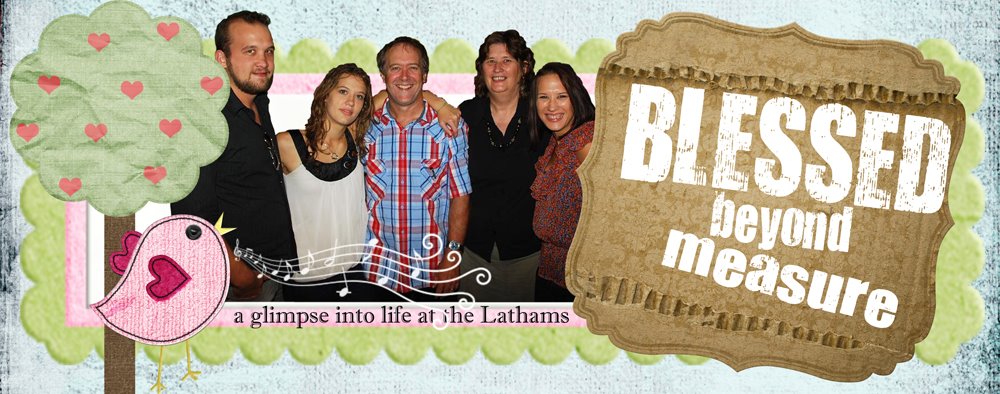

































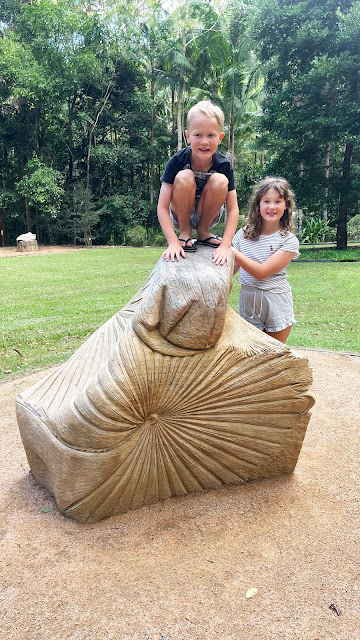



























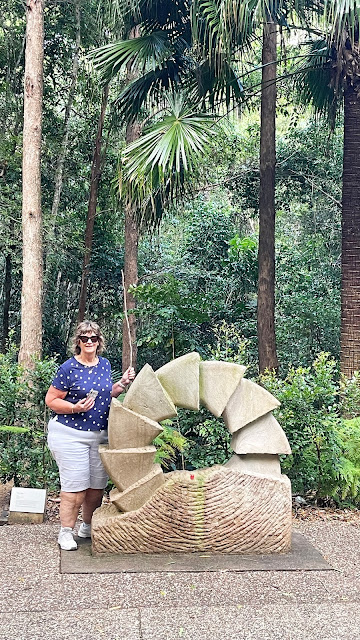






















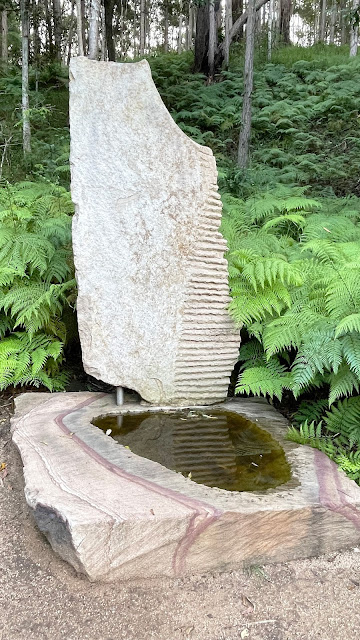


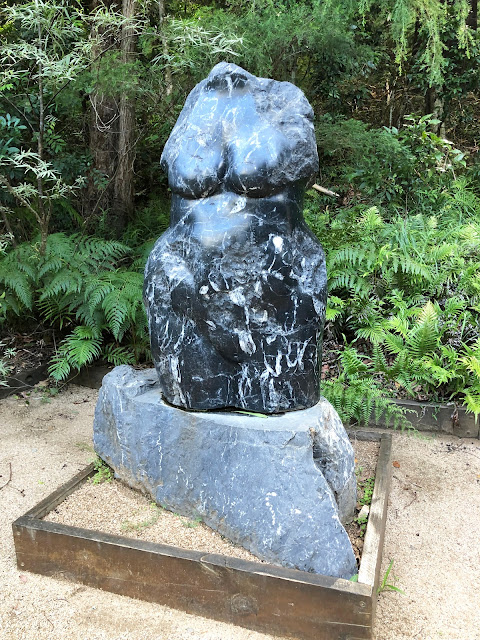






























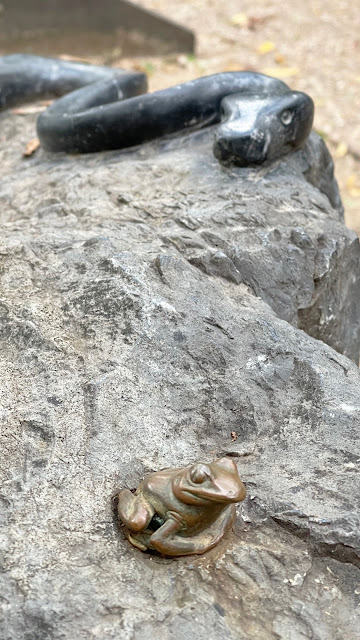
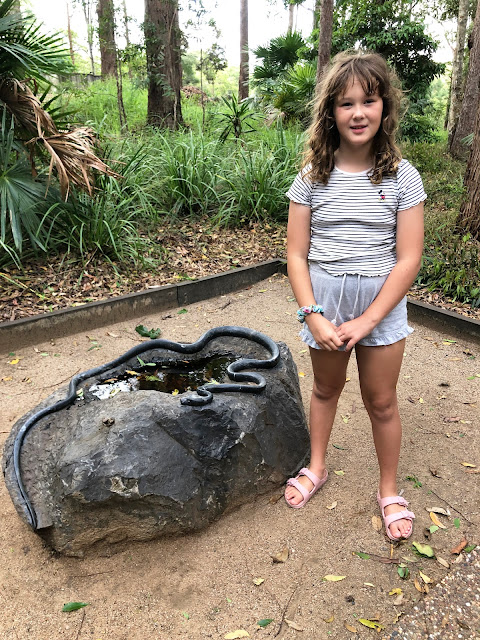










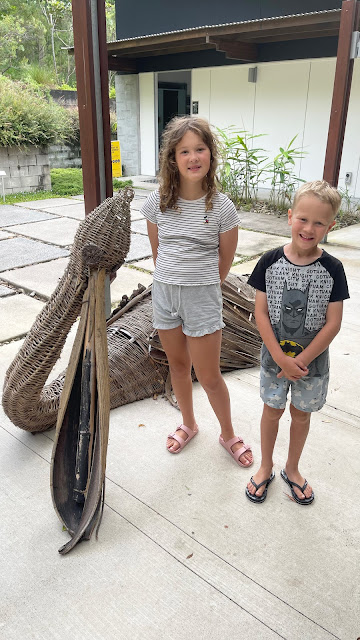



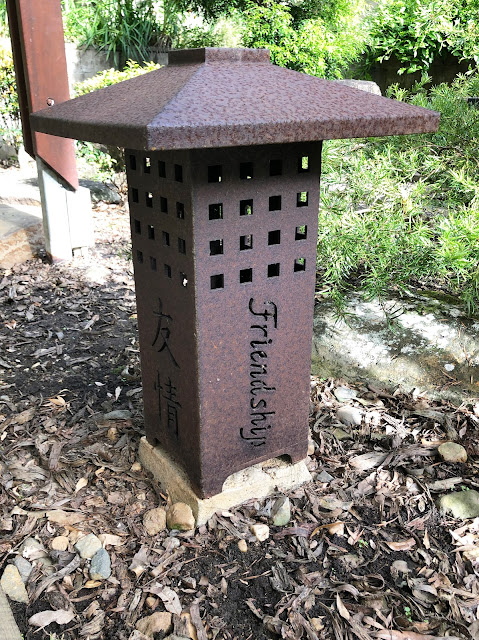











0 comments:
Post a Comment